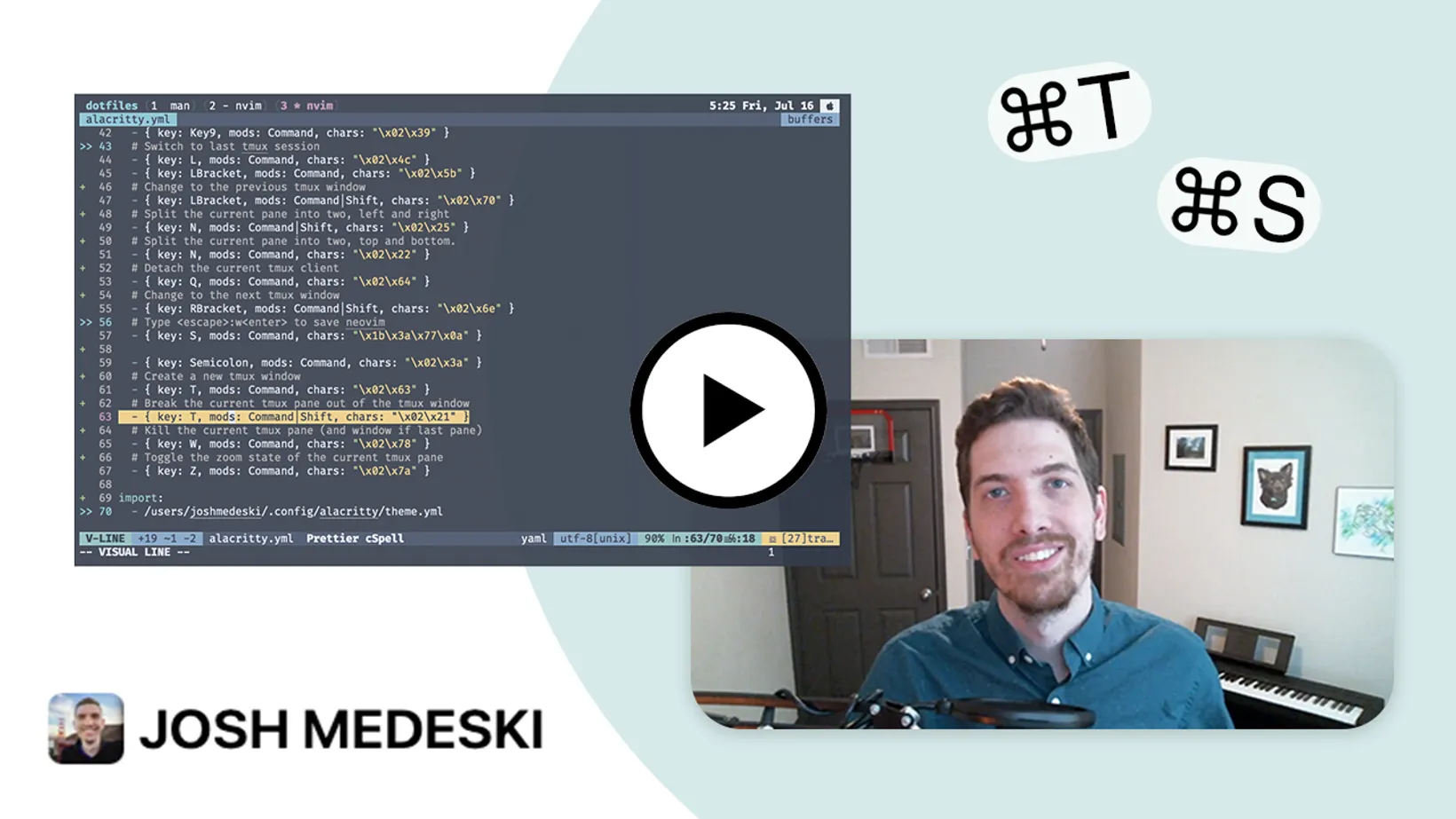macOS Keyboard Shortcuts for tmux
As a longtime macOS user, I am used to using the command key to get a lot done. You’re probably familiar with cmd+c for copying to the clipboard, and cmd+t to create a new tab in Safari. Most power users agree that staying away from the mouse and keeping your hands on the keyboard for as long as possible will help you be faster and more efficient while working.
Unfortunately, tmux is a tool used in the terminal that doesn’t leverage the command key at all, but rather all of it’s commands are prefixed with the keystroke ctrl+b followed by a letter (ex: new window is ctrl+b c). I spent months building the muscle memory for the tmux keybindings, but it always felt slow compared to the macOS keyboard shortcuts.
So, using the Alacritty terminal emulator, I found a way to customize tmux with my own macOS style keyboard shortcuts using the command key.
In this article, I’m going to show you how to create your own keyboard shortcut for tmux. We will go through the following steps:
- Decide the keyboard shortcut
- Get the hex code
- Assign it to Alacritty
1. Decide the keyboard shortcut
Before you can assign the keyboard shortcut you have to decide what you want it to do. tmux uses a prefix (default: control+b) followed by a key to run a key binding. In macOS, keyboard shortcuts are driven by the command key plus an additional key.
As an example, you can create a new tmux window with prefix+c. tmux windows share the same UI pattern as tabs in macOS (ex: Safari tabs or Finder tabs). New tabs in macOS are created with the cmd+t keyboard shortcut.
So let’s bind new tmux window to cmd+t.
2. Get the hex code
In order to simulate a keystroke, Alacritty uses hex codes, which is simply a combination of characters.
For our example, we need to get the hex code values for <ctrl+b> c. We will use xxd to record our keystrokes and dump the hex codes we need.
First run the following command (outside of tmux):
xxd -psdThen type ctrl+b, c, then press the return key (aka enter). You will see the following data output in your terminal:
^Bc02630aPress ctrl+c to escape the xxd listener. You now have the hex code 02630a, which stands for ctrl+b c return.
3. Assign it to Alacritty
Keystroke hex codes are bound to two character at a time. So from our code 02630a, 02 stands for ctrl+b, 63 stands for c, and 0a stands for return. Since we don’t need the return key, we can drop it. Alacritty also wants us to escape each code with \x{hex} so the chars we want to use for <prefix-b> c will be \x02\x63.
Finally, we will use the key and mods keys to define the custom key binding. Add the following code to your ~/.config/alacritty/alacritty.yml config file.
key_bindings: - { key: T, mods: Command, chars: "\x02\x63" }Now, while inside tmux, you can hit cmd+t to create a new window! The principles learned here can be applied to any key binding with any keystroke combination you can think of.
Bonus: Additional Shortcuts
Here are some of the tmux keybindings I have set up with Alacritty to create more macOS like keyboard shortcuts:
key_bindings: - { key: E, mods: Command, chars: "\x02\"" } # split tmux window vertically - { key: E, mods: Command|Shift, chars: "\x02%" } # split tmux window horizontally - { key: F, mods: Command, chars: "lfcd\n" } # open file manager 'gokcehan/lf' - { key: F, mods: Command|Shift, chars: "\x02\x5b\x2f" } # start tmux search mode - { key: G, mods: Command, chars: "\x02g" } # open git manager 'jesseduffield/lazygit' - { key: J, mods: Command, chars: "\x02\x54" } # open t - tmux smart session manager - { key: K, mods: Command, chars: "\x02s" } # open interactive tmux session client - { key: L, mods: Command, chars: "\x02L" } # switch to the last tmux session - { key: O, mods: Command, chars: "\x02u" } # open URLs 'joshmedeski/tmux-fzf-url' - { key: P, mods: Command, chars: ":GoToFile\n" } # files - { key: P, mods: Command|Shift, chars: ":GoToCommand\n" } # commands - { key: Q, mods: Command, chars: ":q\n" } # quit vim - { key: S, mods: Command, chars: "\x1b\x3a\x77\x0a" } # save vim buffer - { key: T, mods: Command, chars: "\x02c" } # create a new tmux window - { key: W, mods: Command, chars: "\x02x" } # kill the current pane - { key: Z, mods: Command, chars: "\x02z" } # toggle zoom state of the current tmux pane - { key: Tab, mods: Control, chars: "\x02n" } # switch to next tmux window - { key: Grave, mods: Control, chars: "\x02p" } # switch to previous tmux window - { key: Comma, mods: Command, chars: "\x02," } # rename the current tmux window - { key: LBracket, mods: Command, chars: "\x0f" } # navigate back in vim (ctrl+o) - { key: LBracket, mods: Command|Shift, chars: "\x02p" } # switch to next tmux window - { key: RBracket, mods: Command, chars: "\x09" } # navigate forward in vim (ctrl+i) - { key: RBracket, mods: Command|Shift, chars: "\x02n" } # switch to previous tmux window - { key: Semicolon, mods: Command, chars: "\x02:" } # enter the tmux command prompt - { key: Key1, mods: Command, chars: "\x021" } # select tmux window 1 - { key: Key2, mods: Command, chars: "\x022" } # ... 2 - { key: Key3, mods: Command, chars: "\x023" } # ... 3 - { key: Key4, mods: Command, chars: "\x024" } # ... 4 - { key: Key5, mods: Command, chars: "\x025" } # ... 5 - { key: Key6, mods: Command, chars: "\x026" } # ... 6 - { key: Key7, mods: Command, chars: "\x027" } # ... 7 - { key: Key8, mods: Command, chars: "\x028" } # ... 8 - { key: Key9, mods: Command, chars: "\x029" } # ... 9To see my latest keybindings, check out my full alacritty.yml file on GitHub
Sign-Up for New Posts
Stay in the loop and get the latest blog posts about dotfiles sent to your inbox.
Or use the

